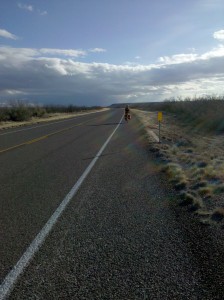This guy, Pat O’Bryan, has a complete understanding of the blues. This is in Terlingua, TX. outside of Big Bend National Park….outstanding music is only one of the reasons Texas is a great place to tour!
Tag: Texas
Great State for Bike Touring.
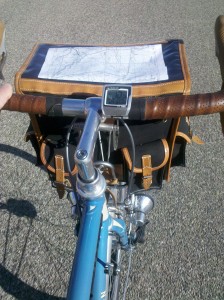
There are two occupants in the grey Honda Element and as they drive past me the passenger shrieks some sort of primal scream. I don’t think it is meant as encouragement to me. I don’t think I did anything to irritate these people, but maybe I did. Maybe I forced them to slow down or maybe they thought I was taking up too much of the road. Maybe they don’t like the way I look. Maybe their brains are scrambled from too much TV. Contravening my own guidelines, I take one hand off the handlebars and give them the universal sign indicating I think they are number one. Up ahead, impeding upon their forward progress is a stop sign, and seeing them slow down I increase my pedaling cadence in the hopes of overtaking them in order to assess the source of their obvious displeasure with me riding my bicycle. Briefly I wonder what I would do if I overtake them. Will I need some protection? What about the frame pump? Oh yes, I think, I have a can of pepper spray in my bag. Emboldened by that realization, a couple miles later, when they overtake me again, and the passenger issues forth with another similar greeting, I respond in kind and suggest they stop in order to discuss our grievances in a civilized manner. They don’t stop. By that time I have the pepper spray strapped to my hand and if they do stop and the conversation is less than civilized, at least we will have some entertainment. This is a scenario I have played over in my head ever since Juan Butler knocked me the fuck out after a similar altercation a few years ago. Since the pepper spray would only temporarily disable my assailant(s) I would need to grab the car keys and take them with me….otherwise I would be like a sitting duck on the bike once the driver recovered.
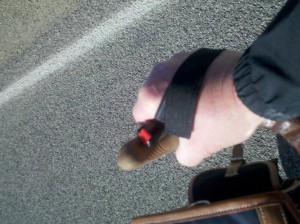
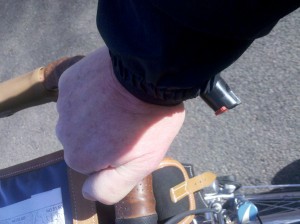
I have ridden my bike through two dozen of these United States. So far I would have to say that Texas is my favorite place to tour on a bicycle. The shoulders are broad and the drivers are courteous. Many people stop to see if you are OK or if you need anything or just to shoot the breeze, and sometimes to offer a place to stay. Me and Gary P. Nunn are down with Texas;
“the friendliest people and the prettiest women you’ll ever see“.
I would have to say that the state I’ve called home for the last two and a half decades is my least favorite place to ride a bike. In fairness to Idaho I’ve spent many more hours on the road here than any other state but over the years, having motorists yell at me has been the least of my worries. I have had plastic liter bottles and water balloons hurled at me from moving vehicles. And it was here, in Boise, that the aforementioned individual stopped his car and physically assaulted me. The only other occurrence that comes close was in the Smoky Mountains of Tennessee when a car drove up behind me so stealthily I didn’t even hear it and the passenger tapped me on the butt as they slowly drove past. I think Clem was just trying to be friendly though so I can’t even get mad about that.
Now, far be it from me to agitate the already turbid waters of motorist/cyclist relationships. I do not advocate for any sort of reaction or retaliation for alleged wrongs of either party. I don’t place any blame nor do I hold out much hope for advocacy to change behaviors. I just want to ride the bike. I always ride defensively and I go out of my way to avoid confrontations with automobile drivers. But I will not let some confused, angry and ignorant people keep me from doing what I enjoy. Ignoring the fact that there are simple minded, people who are frightened, stressed out, hurried, bored and over-stimulated all at the same time, while behind the wheel of a car, is not wise either.
I also want to make it clear that, in my experience, drivers are much more courteous to riders in normal-ish clothing and with racks and bags on the bike than to riders dressed in racing strip. I have NEVER been harassed by motorists when touring, in fact the opposite is true- people are generally curious and very friendly…..or else they just ignore you because they think you are a little bit crazy.
The tactical flashlight as a means of self defense was meant as sort of a joke but if our goal is “Empowering the Bicycle Traveler” I feel I would be derelict not to address the very small chance of needing to defend oneself. I bought my pepper spray at the local Cop Shop and it is set to shoot a stream of spray. Pepper spray is legal in all 50 states but I don’t claim to know all the details of the legality of its use. I assume that in a legitimate self defense situation a person would be justified in using it. I also assume that simply riding up to a stopped car and spraying the person who just yelled at you would probably not be cool.
I don’t understand why we are so mean to each other. We get to drive our cars and go out on our bikes but we are still not satisfied. We feel the urge to fight with each other and mark our territory. Human nature I guess. Unfortunate, but I think one needs to be realistic.
In March of 2011 I rode across East Texas and Louisiana. I wanted to ride through south Louisiana into New Orleans but it was difficult to find information about cycling routes and the possibilities of getting stuck and lost in the swamps was a little too daunting and so I stuck with the Adventure Cycling maps of the Southern Tier. Since then I came across this guide originally posted on crazyguyonabike by Don Weinell and he kindly gave me permission to reprint it here. I really appreciate Don’s well researched and documented article. Sounds as though this could be a nice little adventure. So without further ado:
Note – 25 Apr 2011: I made a correction regarding the Wisner Boulevard Bike Path in New Orleans. It stops before the I-610 bridge, not the I-10 Bridge.
Note – 22 Feb 2011: I’ve changed the name of this article so that it will be more easily found by non-CGOABers doing a Google or Bing search.
I recently posted a link to Google Maps for an alternate route across south Louisiana. Unfortunately sometimes this link worked, sometimes it didn’t. So I’ve decided to embed the maps here and add more detailed explanations of the route. I’ve also deleted the other posting.
First, a few general comments about riding in south Louisiana:
While most of our federal highways have shoulders, very few state and parish highways do. If shoulders are present, they are usually poorly maintained.
Riding on the Interstates is illegal. The other main US highways across south Louisiana are US 190 and US 90. Both are busy roadways and should be avoided as much as possible by cyclists. East of New Orleans, however, US 90 is your only option.
Unless you are riding on the Southern Tier, chances are you will the first bicycle tourist most drivers here have ever seen. As a whole, our drivers are no less courteous than drivers elsewhere; they’re just not used to watching for cyclists. This means you have to be extra cautious around traffic.
Free roaming dogs are not nearly as common as they used to be, but in rural areas you still might get chased from time to time.
This may sound like a cliche’, but in south Louisiana, especially in southwest Louisiana, alligators really do cross the road (to get to the other side, of course). I can’t even remember the last time someone was actually attacked by a gator. Like all wild animals though, you should not provoke them. They are quite fast over short distances. Don’t try to get close to take a picture. Just let them cross and then you can be on your way.
Mosquitos, on the other hand, will chase you mercilessly. DEET is your best friend.
In southwest Louisiana there are still areas where cell phone service is not available.
I’ve divided the route into two separate maps; one for southeast Louisiana and one for the southwestern section. My comments are arranged as you ride from east to west. In downtown New Orleans, and in a couple of smaller towns, many of the streets are one-way. If you’re travelling from west to east, you may have to deviate one block to either side of the mapped route to accommodate the one-way traffic patterns.
Southeast Louisiana

Pearl River: The Pearl River forms the eastern boundary of this part of Louisiana. The US 90 bridge is located just west of Pearlington, Mississippi. The bridge doesn’t have shoulders, but luckily it’s flat, not very long, and usually doesn’t have much traffic.
The Rigolets: The Rigolets is the main water connection between Lake Pontchartrain and the Gulf of Mexico. Google Maps’ Street View still shows the old (and dangerous) drawbridge that was replaced after Hurricane Katrina. The new bridge is taller, but has nice wide shoulders and is much safer for cyclists.
Fort Pike: Built in the 1820s, Fort Pike protected New Orleans from potential invasions through Lake Pontchartrain. It is now a State Historic Site. Recent budget cuts have forced the closure of the park to visitors except by appointment, but you can get a good view of it from the highway.
New Orleans: Like any large city, there are good areas and not-so-good areas of town. My route through New Orleans will keep you out of the rougher neighborhoods, and still let you experience the flavor of the city that is uniquely New Orleans. The only way to enter the city by bicycle from the east is along US 90. This highway is really not too bad until you get into the city. The closer you get to New Orleans, the more congested it gets and the more seedier the surroundings become. The east side of New Orleans was flooded during the aftermath of Hurricane Katrina, and the scars (more like open wounds) are still very visible.
Bullard Avenue: There are several main roads that turn north from US 90. Bullard Avenue is busy, but it’s much better than Read, Crowder, or Downman. A couple of new chain hotels (Holiday Inn Express, La Quinta, and Comfort Suites) are located where Bullard crosses under Interstate 10.
Morrison Road: As your bones get jarred by the poor pavement of Morrison Road, you’re bound to think “There’s gotta be a better way!” Trust me, there isn’t. All of the roads in this area are bad. They were never great, but being under water for a week or two made them even worse. Also, for some unknown reason that defies logic, Morrison Road between Read and Bullard is one way (west) on the north side of the canal, but two-way on the south side of the canal.
New Orleans Industrial Canal: Three bridges cross the New Orleans Industrial Canal. One is the I-10 bridge, so that won’t do you any good. The second is the US 90 bridge. It has a pedestrian walkway, but the risks involved with just getting to the bridge far outweigh the benefits of the walkway. Your safest choice is the bridge on Leon C. Simon Drive, the one I’ve plotted on the map. It doesn’t have shoulders or a walkway, but it has less traffic and is in a somewhat safer part of town.
Leon C. Simon Drive: Normally I would have recommended you ride along Lakeshore Drive after crossing the Leon C. Simon bridge. Currently, however, there is so much construction around the University of New Orleans and Southern University that it’s impossible to get to Lakeshore Drive. So, for the time being, it’s better just to stay on Leon C. Simon Drive until you get to Robert E. Lee Boulevard. Continue west for a short distance on Robert E. Lee Boulevard until you get to Beauregard Avenue.
Wisner Boulevard Bike Trail: As you turn south onto Bearegard Avenue from Robert E. Lee Boulevard, the road changes names to Wisner Boulevard. You’ll see a well-marked, paved bike trail that runs between Wisner Boulevard and the canal. It ends right before the Wisner Boulevard bridge over I-610.
City Park: One of the great urban parks in the country. It was devastated by Hurricane Katrina, but private contributions are helping it to recover. The New Orleans Museum of Art is located within the park.
Esplanade Avenue: As you leave City Park and head towards the French Quarter, you’ll ride along Espanade Avenue. This road, like most of the roads you’ve been on so far, has two lanes in each direction separated by a median. On Esplanade, however, the outermost lane in each direction is pretty narrow. Most vehicles stay in the left lanes. Cars park along the street, so your biggest danger is probably from doors opening. There are sidewalks on both sides, but given the amount of pedestrians, it’s usually safer and faster to stay on the road.
French Quarter: What can I say about the French Quarter that hasn’t already be said by many others? As you ride through this part of the city, make sure you visit the French Market. You may also enjoy seeing the rare white alligators at the Aquarium of the Americas.
St.Charles Avenue: This is likely the second most well-known street in New Orleans (behind Bourbon Street). Downtown, St. Charles is one-way, but after a traffic circle it becomes two-way. Like Esplanade, St. Charles Avenue west of the circle has two lanes going in each direction separated by a median. In this median you’ll see the famous New Orleans streetcars travelling down the tracks. St. Charles Avenue is lined with restaurants, shops, and old homes. A lot of joggers use the median, dodging the streetcars occasionally, so most of the drivers are on alert.
Audubon Park: Another great greenspace of the city. It is home to the Audubon Zoo and Insectarium.
Mississippi River Levee Trail: This is the longest true bike path in the city, and the easiest way to leave New Orleans heading west. It begins at the south edge of Audubon Park, is paved, and extends 20 miles to Ormand Boulevard in Destrehan. As you leave Audubon Park on West Drive, it becomes one-way out of the park. Immediately after you cross the railroad tracks, you’ll see the start of the bike trail on your right. Pay attention; it’s not marked and if you’re watching other traffic you might miss it.
Bonnet Carre Spillway: While riding on River Road, you’ll pass to the north of the Bonnet Carre Spillway floodgates. During times of exceptionally high water levels on the Mississippi River, the floodgates are opened to divert water to Lake Pontchartrain. The idea is to reduce pressure on the levees of New Orleans. During dry periods, motorcyclists, ATVers, and mountain bikers enjoy riding on numerous trails within the spillway.
Reserve-Edgard Ferry: The Reserve-Edgard Ferry is the easiest and safest way to cross the Mississippi River. Unfortunately it only operates on weekdays from 5:15 AM to 8:00 PM. The ferry is closed on Saturdays and Sundays and sometimes due to weather or mechanical issues.
Gramercy Bridge: Heading east to west, the Gramercy Bridge should be your second choice for a river crossing. It is tall and long, but it does have wide shoulders. The shoulders, however, have diagonally placed reflectors on the pavement (obviously designed to force cyclists to play in the traffic). I would definitely consider walking my bike over this bridge. If, on the other hand, you are travelling west to east, do not pass this bridge by without first checking the status of the Reserve-Edgard Ferry. To get the latest ferry status, call 1-888-613-3779 for recorded information. Also, don’t get suckered into trying to cross the Sunshine Bridge at Donaldsonville; it’s a much more dangerous bridge for cyclists!
Oak Alley Plantation: Oak Alley is perhaps the most photographed plantation home in Louisiana. As you ride by, you’ll understand why. They have an inn on-site, and I’ve heard that they occasionally allow cyclists to pitch a tent on the grounds.
Cane Row RV Park and Truck Stop: Located west of the intersection of LA 70 and LA 3127, I normally wouldn’t consider camping at this spot. If you’re running short on daylight, though, this is the only campground anywhere nearby. Most of the campers appear to be semi-permanent residents or snowbirds. On the plus side, there is a restaurant and convenience store on-site.
Cajun Cabins: These cabins are on LA 70 at Bayou Corne (east of Pierre Part). They are mainly used by fishermen, but they have a few RV spots next to them. I’m sure tent campers would also be welcomed. The cabins are clean, and there’s a fishing pier that makes a nice place to relax after a hard day’s ride.
Pierre Part Store: This is one of the few small town general hardware stores that hasn’t been crushed under the heels of you-know-who. That in itself is worth a visit to buy something.
Lake End Park: A small, privately owned, well established campground on the west side of Lake Palourde. It might seem a little expensive (around 25 dollars I think), but it’s the only such campground near Morgan City.
International Petroleum Museum: If you’ve ever wanted to see an offshore drilling rig up close and personal, this is the place to do it. The musuem is located on the east bank of the Atchafalaya River in downtown Morgan City.
Lake Fausse Point State Park: This state park is located within the Atchafalaya River basin (the largest freshwater river swamp in the US). In addition to camping, they have excellent waterfront cabins. You can also rent a canoe and follow well-marked paddling trails in the swamp.
Southwest Louisiana

St. Martinville: This is the legendary home of Longfellow’s fictional heroine Evangeline. A monument and museum on the banks of Bayou Teche tell her story. Just north of town on LA 31 is the Longfellow-Evangeline State Historic Park. Here you can learn about the origins of Louisiana’s Acadian culture.
Avery Island: When you think of hot sauce, you think of Tabasco. And when you think of Tabasco, you think of Louisiana. Avery Island is the home of Tabasco. Here you can visit the actual factory and, depending on the time of year, watch the various stages of production. Across from the Tabasco factory is Jungle Gardens. The gardens are a great place to bird watch and see alligators. A 900 year old statue of Buddha forms the centerpiece of the gardens.
Delcambre: At Delcambre, you can go straight west on LA 14 to Abbeville, or you can follow my route south and back around to Abbeville. LA 14 is a four-lane highway with lots of traffic and a 65 mph speed limit.
Palmetto Island State Park: Louisiana’s newest state park, Palmetto Island is also slated to close in June, 2011, due to state budget cuts. Hopefully additional funds will be found to keep it open. Until then, camping, hiking, and cabins are available in the park.
Intracoastal Waterway: This man-made canal allows ocean going vessels to sail between New Orleans and Houston without actually getting into the unprotected water of the Gulf of Mexico. The bridge over the ICWW is long and tall, but a wide shoulder is present.
Pecan Island: Even though it looks like a town on maps, Pecan Island is actually just a concentration of homes and hunting/fishing camps that extends five or so miles along LA 82. One convenience store and several small RV parks are located in this area. Even though they are called RV parks, some are well suited for tents due to the parking spots being grassy.
Rockefeller State Wildlife Refuge: I’ve been visiting Rockefeller Refuge off and on for over 30 years. It is a remarkable place. Hurricane Rita (the other hurricane) in 2005 severely damaged most of the buildings. A few have been repaired, but many are still awaiting renovation or demolition. The refuge normally doesn’t allow camping, but if you visit the headquarters near the western boundary, and ask nicely, they will probably let you to pitch a tent overnight. Just remember that there are no amenities available. Also, if you get permission, try to ride out to the end of Price Lake Road. Depending on the season, numerous species of waterfowl may be seen.
Rutherford Beach: Where LA 82 turns sharply to the north towards Creole, you can cross the canal and continue west for one mile. Turn south onto Rutherford Beach Road and follow it around for 2.5 miles to the beach. Not much is left here since Hurricane Rita, but you have access to the beach. All beaches in Louisiana are considered public, so if you’re looking for a free place to camp, this is as good as any.
T-Boy’s Cajun Grill: Return back to LA 82 and head north to Creole. Located at the intersection of LA 82 and LA 27, this restaurant is very popular with the locals for two reasons. First, it’s the only place to eat for miles around, and secondly, the food is really good. My recommendation is the chicken and sausage gumbo. It’s among the best I’ve ever had.
Cameron: Cameron is the closest thing to an actual town in this area. It was almost wiped away by Hurricane Rita. A number of new buildings have been constructed, but the population is still far less than before the storm. Many empty foundations are visible. There is one motel in Cameron, appropriately named the Cameron Motel. There are no other motels within possibly 40 miles. I have heard, but I’m not personally familiar with this, that free camping is allowed south of Cameron near the jetties.
Cameron Ferry: This ferry is the only way to cross the Calcasieu River south of Lake Charles. North of Lake Charles there are two bridges along US 171, but neither have shoulders. The Cameron Ferry runs 24 hours a day, seven days a week.
Holly Beach: At Holly Beach you have another major choice to make. You can continue riding west on LA 82 for another 26 miles to the Texas state line. This route through Louisiana is fine, but you run into a problem eight miles into Texas. The bridge over the Port Arthur ship channel is old, tall, long, and dangerous for cyclists. There is no shoulder at all, and the ramps are steep. This bridge is the only way to cross the channel. Unless you have a real reason to enter Texas here, you should definitely avoid this route. My recommendation is to turn north onto LA 27 at Holly Beach and cross into Texas further up at Deweyville. At Holly Beach, there is a small RV park, but no stores.
Sabine National Wildlife Refuge: Assuming that you chose to follow my advice, as you head north from Holly Beach you will soon enter the Sabine National Wildlife Refuge. About 2.5 miles into the refuge from the south, you will find a paved nature trail that leads westward into the marsh to an observation tower. Along this trail I’ve seen all sorts of snakes, alligators, nutria, rabbits, and a variety of birds. Again, make sure you have plenty of bug spray.
Hackberry: I’m not aware of any camping near here, but there are several small hotels in Hackberry that cater to hunters and fishermen. Some are nicer than others.
Delta Downs: This is a horse racetrack and casino, and not someplace you would normally think about staying. They do, however, have a nice hotel on-site. Delta Downs is located on LA 3063, about 2.5 miles west of Vinton.
Niblett Bluff Park: Niblett Bluff Park is the last good camping area before you leave Louisiana. It is a small community owned and maintained park located on Niblett Bluff Road, about 2.5 miles west of the intersection of LA 3063 and LA 109.
Sabine River: As you cross the Sabine River, you’ll leave Louisiana and enter Texas at Deweyville. The LA 12 bridge over the river has no shoulders, but it’s short, flat, and has only minimal traffic. If you continue west from Deweyville on TX 12 for three miles, then turn north on TX 87 and ride 31 miles, you’ll connect with the Southern Tier just east of Kirbyville, Texas.
So, that’s the grand tour of south Louisiana. I hope you enjoy your ride through some of the most ecologically and culturally unique areas of our state. From New Orleans in the east, to the marsh prairies of the west, south Louisiana has a lot to offer if you take the time to look. If you have any questions, post them in the guestbook and I’ll do my best to answer them.
You Ask Me What I Like About Texas
Sky King’s take on Austin
While much of our time in Austin was spent inside at the North American Handmade Bicycle Show, we did get out and about a bit. Most of these photo’s were taken with my phone but thought it would be fun to give you a little view of some of the things we saw.
I must confess, on day one, we observed a gentleman riding his bicycle wearing nothing but a G-string, way too much information for us. Needless to say we decided no one else needed to be exposed to that either.
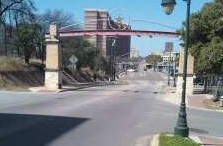
As a bit of a history nut, I imagine this Arch as an entrance to East Austin that the community installed to declare a neighborhood existence beyond downtown Austin. Now somewhat drawfed by I35 it still stands with pride.
Also in East Austin was this funky neighbor music venue and some interesting tiled mosaic murals.
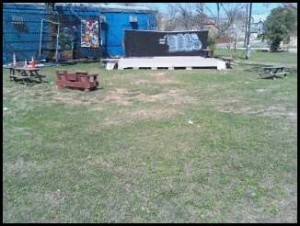

Eating at Scholz Garten, was a treat, Only a few blocks from the stadium where the Texas Longhorns play basketball, the place was packed with people wearing orange t-shirts with longhorns but cleared out quickly once the game commenced. Scholz was established in 1866 and prides itself in serving German Food but they also make a pretty decent pulled pork sandwich!
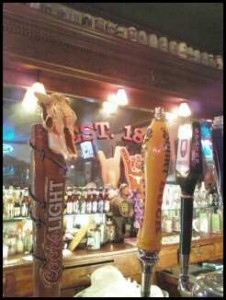
Our “go to” beer in Austin quickly became the Live Oak Big Bark, interesting taste, not real hoppy and a bit of blend between a black IPA and a Red Ale. Of course Jim could probably go into way more detail, but I just drink them.
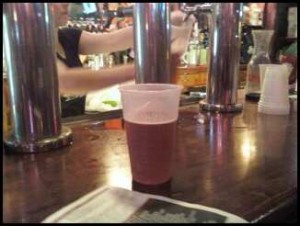
Mellow Johnny’s was a big supported of the North American Handmade Bicycle show. They hosted a huge party Friday night but didn’t have honky tonk so we cruised the shop and then departed. We are happy to say they are a dealer for Zimbale North America and had the bags displayed beautifully. To bad this photo doesn’t do justice to this bike. Similar to the Surly Big Dummy and Mellow Johnny’s decked it out with propane hot plate and mixing bowls – was pretty entertaining. The panniers are Giant – could probably stuff two kids, all the groceries and the kitchen sink.
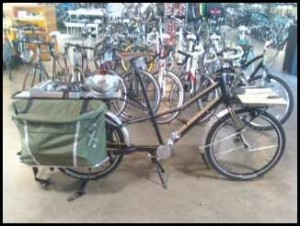
The Bike Hermit has the highest metabolism of anyone I know so finding Whole Foods was on the top of the list. The Austin store is the flag ship and a must visit for anyone who goes to Austin. I thought this “desert” stream in their landscaping was quite pleasant and deserving of a photo.
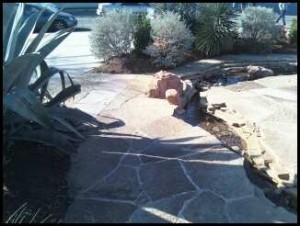
As I failed to do much research prior to our trip regarding bike rental options, I was the queen of walking. BUT just so you know, Austin Bike Tours and Rentals not only rents bikes they deliver and pick them up when you are done – DANG
I walked past this very clever bike rack, if you have any old frames in your garage, just weld them together!
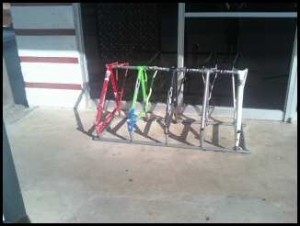
NAHBS , Day One
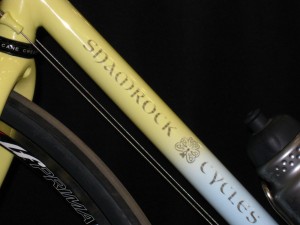
As promised, here is a pic of Tim O’Donell’s fillet brazed road bike. We are right next to YiPsan Bicycles‘ booth. Renold has some good ideas. Especially the porteur/low rider front rack. The two side platforms on the front rack come off and attach to the lower stays to support panniers. A really clever solution and one that I’m sure will be reproduced in a production way by somebody judging from the number of photos taken during the day. When you see it, know where it came from.
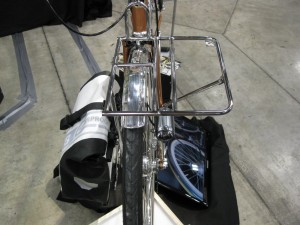
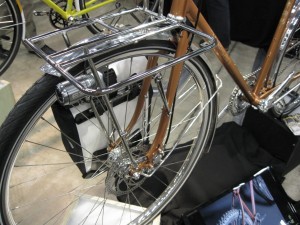
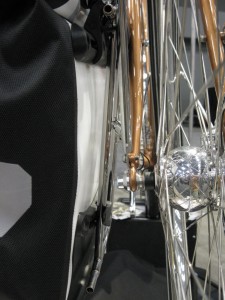
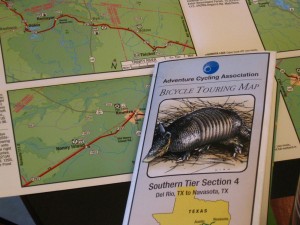
There was new snow on the ground again this morning with more forecast for the rest of the week. I check the forecast for Texas and Louisiana and am pleased to see that temperatures are predicted to be in the 70’s during the day and merely down to the 50’s at night for at least the next week. There is some rain in the forecast and according to the Adventure Cycling map I just got on the mail, Louisiana receives on the average in February and March as much precipitation as this part of Idaho gets in a year. Since my hammock and sleeping pad will travel strapped to the sides of my rear rack I decided I better address the probability of them getting wet.
After brushing the snow off the car we made our way to the Army Navy store where I found some compact and lightweight dry sacks of the perfect size. Since I already have a waterproof compression sack for my sleeping bag, I think I am all set in the riding-in-the-rain department.
The remainder of the afternoon has been spent developing a reasonable schedule so that I could book a hotel room in New Orleans and a flight home. That and reading Sue Gray’s account of her ride on the same part of the Southern Tier earlier this month in some abberantly cold weather. My last two tours have been sort of aggressive from a time allowed standpoint, especially last year, when I did 850 miles in 11 days of riding for an average of 77 miles per day. This year’s route is about 700 miles and I figure I can do it comfortably in 12 days which averages to about 58 miles a day. As an extra cushion I am allowing for one rest day, with zero miles, and one day in New Orleans to get the bike packed and ready to ship back.
We are leaving for Austin on Wednesday. I still need to pack my bike and get it to FedEx tomorrow in order to feel comfortable about it getting there before the end of the week. Stacy flies back home on Tuesday March 1, my first day on the bike.
I leave in one week so I am focusing on those items on the critical path. Items without which the tour cannot be accomplished and which have longer lead times.
Item number one is a box to ship the bike. Rather than a softsided or other airplane friendly case I ordered a re-usable cardboard box like the one I used on the last two tours which is pretty ratty now and besides, I used it to ship a bicycle back to Rivendell last year. I should receive it on Friday. That will leave the weekend to unbuild the bike and pack it so that I can take it to FedEx on Monday. I will send it to the motel in Austin where we are staying. I suppose I could do the same with a conventional, and more durable bicycle case but those all cost more than I want to spend. I can do a dozen tours using 3 or 4 of the cardboard boxes and still be ahead.
Item number next is ordering a map of section 5 of the Southern Tier from Adventure Cycling Association. These maps are so detailed and so refined over the years they have been in use that I get a little nervous when I need to detour from them. It’s also comforting to think of all the other bike tourists who have been along these same routes if only because of the assumption that local motorists might be more aware of bicyclers.
I also plot the route on Google Maps.
View Austin to New Orleans in a larger map
This is not the exact route but for some reason Google Maps would quit letting me make changes after some amount of time or changes.
Since the Southern Tier route only goes to St. Francisville, LA I had to find a way to get through Baton Rouge and into New Orleans. I have been spending some time on the bikeforums.net touring forum and I thought I would put the question to that group. I did a quick search of the forum for routes in New Orleans and was directed to several threads, and I found out about the Mississippi River Trail. From their website:
The Mississippi River Trail, coursing along America’s backbone, the Mississippi River, from its headwaters in Itasca, Minnesota to the Gulf of Mexico, offers approximately 3,000 miles of on-road bikeways and pedestrian and bicycle pathways for the recreational enjoyment, health, conservation and tourism development of river communities, river states, and the nation.
I was able to plot a route, which I’m hoping is pretty decent for cycling, from St. Francisville into New Orleans.
So now I can use my maps to figure out the best places to end up each day. Since I want to go as inexpensively as possible I will be looking for KOA campgrounds and state parks with showers, and I am going to register on the warm showers website to see if I can score some free overnight stays.
“…now the sky is gettin’ light
everything will be alright
I think I finally got the knack
just floatin’ and lazin’ on my back
I never really liked that town
think I’ll ride the river down
just movin’ slow and floatin’ free
this river swingin’ under me
wavin’ back to folks on shore
I should have thought of this before
I’m goin’ on down to New Orleans
pick up on some swingin’ scenes
I know I’ll know a better day
goin’ down groovin’ all the way…”
Micky Dolenz, “Goin’ Down”
Yep, the bike hermit is goin’ on down to New Orleans. Since we are going to be in Austin for the North American Handmade Bicycle Show in February, I started to think about ways to take advantage of being in the south while Idaho emerges from the cold, wet winter months. That thinking has evolved into a bicycle tour from Austin to New Orleans. I will load Chief and journey out on section 5 of the Adventure Cycling Association‘s Southern Tier Route, from Navasota, TX to St. Francisville, LA., and from there down to the Big Easy. Since I am self-absorbed and delusional enough to think people I don’t even know might be interested, I have decided to document my daily planning and preparation tasks, the ride, the trip home and any epilogues.
A simple Google search will uncover a plethora of web pages with itemized lists of what other people take on a bicycle tour , and I think those lists are boring. So I won’t be doing that. Some people have created spreadsheets to plan their itineraries and to document the daily mileage, weather, lodging, food and probably bowel movements. I’m not going to do that either. I want to speak in more general terms about the process of conceiving, planning and executing this bike touring trip as I figure it out. About things that I find out and discover as I explore how to get from here to there by bicycle. The whole concept to me is about freedom. I’m free to ride my bike all day if I want. Indeed, I’m free to ride all night if I feel like it. I’m free to stop whenever and wherever I want. I can go as fast or as slow as I want. All this freedom within limits of course. I do need to complete the ride and come home on the designated day. But everything in between getting on the bike in Austin and getting off in New Orleans is going to unfold as it will. I am literally just along for the ride. And the beer.
Deserts
“One of the qualities that draws me to deserts is their sparseness. I go to be scoured by their winds, purged by their silence, humbled by their searing sunsets. The desert dirt, which accumulates in the chapped cracks of my fingers and the pores of my face, brings me solace. It somehow stills the subtle anxieties produced by living in a culture in which what you do is so often mistaken for who you are, where artificialities obscure essences. Immersing in the desert’s simplicity is akin to a ritual purification. As the earth stands naked, so I am stripped to my unadorned self, with little to distract me from the truths of my life.” So writes Michael Benanav in his excellent account of traveling through the Sahara with a camel caravan to the salt quarries of Taoudenni and back to Timbuktu, Men Of Salt.
Apparently I find something about deserts intriguing as well. I live in Boise, Idaho which with 11 inches of rainfall annually is a high desert environment. Early in 2010 I traveled to west Texas to ride my bike through the Chihuahuan Desert and in early 2009 I rode through Death Valley, smack dab in the middle of the Mojave Desert. Granted, these trips were designed to escape the doldrums of February in Boise, and I’m not sure I would be as fascinated by these deserts in the summer with temp’s in the low triple digits.
I came across this article about Ballarat Ghost Town in Death Valley and a hermit known as Seldom Seen Slim on the Rough Riders website.
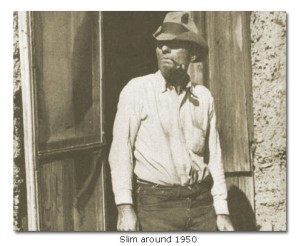
Chris Kostman is behind the Rough Riders website as well as AdventureCORPS Chris organizes several rides in Death Valley and southern California. I intend to take part in one of his Rough Rider Rally rides soon.
The Adventure Cycling Association’s Utah Cliffs route is another desert trip I want to take. Sky King and I did an overnight bike trip in Zion National Park a couple years ago and that country is really beautiful with red rock cliffs and sub alpine forests.
Admittedly, the bike hermit is a little different. My brother doesn’t understand why I would go off and submit myself to the deprivations of bike touring and he doesn’t understand why I go to remote and barren locations to do it. Let me do some ‘splainin; The severe climate of the desert breaks my life down to the most basic elements like it breaks the rocks into sand. The detrition of the wind loosens the sediment in my brain and the subsequent silence when the wind dies makes it possible to listen to the voices in my head. The scenery takes some effort to appreciate sometimes but like anything that requires effort, the rewards are more satisfying. Unlike Montana where around every bend is another postcard view, and you become numb to it after a while. The trips through the desert that I have taken, by myself, have been among the most memorable and rewarding experiences of my life.

